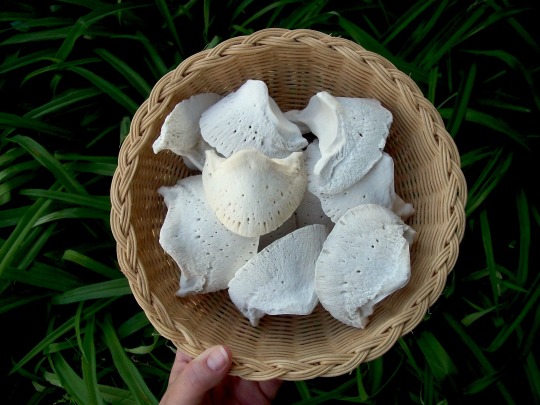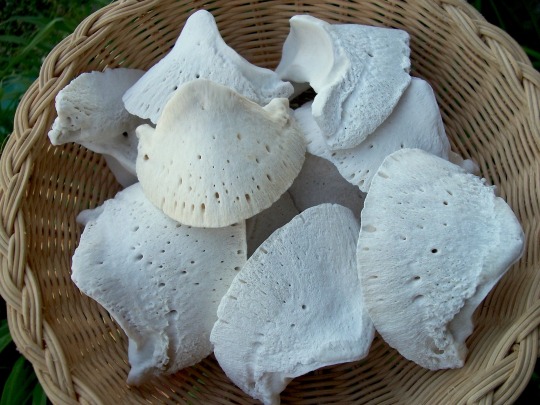Text
i think im lucky to have land spirits that really like me. ive been living in this house for 26 years, i moved here at age 1. i grew up with the plants and trees growing in my yard. i remember one year in elementary school i was big enough to hug my sycamore all the way around, and never again because it grew so big so fast. i remember sobbing in my house when the lavender bushes got pulled because even though i was allergic i loved them so much. i remember making collages out of various leaves and flowers found in my yard. i remember making evil soups and potions out of various plant bits and berries. the spirits in my yard, the spirits of the land i live on, they were present my entire childhood, and like the sycamore, some grew up along with me. i feel fortunate to have realized the relationship i have with these beings. they are so fond of me because they raised me. theres so much love there im just so happy i got into witchcraft so i discovered it was there.
5 notes
·
View notes
Text
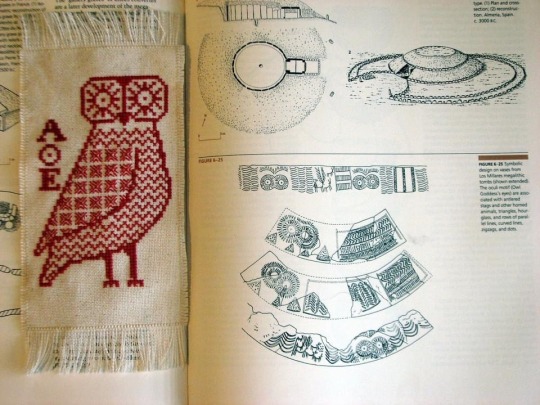

Athena bookmark
40 notes
·
View notes
Text

Intricate Pomegranate Candle
Beeswax candle, hand poured in Los Angeles
84 notes
·
View notes
Text
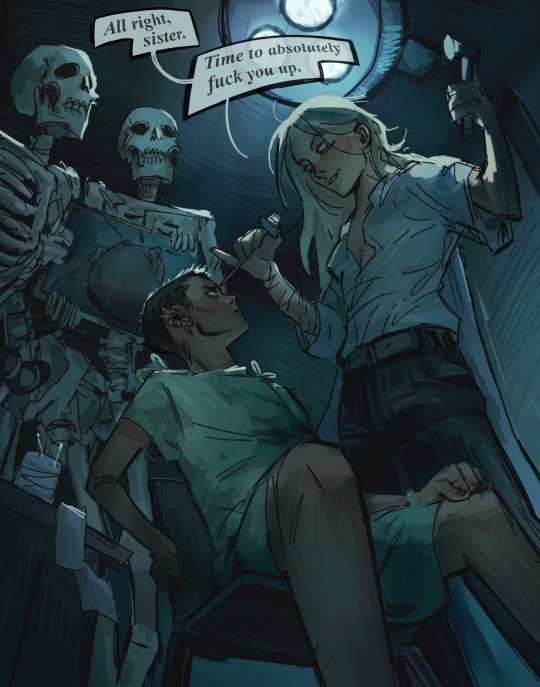
harrowhark getting her lobotomy done at claire's
(ps: merry christmas eve! you can't see but we just hit 10k on here... my christmas gift to the world, thank you dearly)
26K notes
·
View notes
Note
what exactly is a nurse log?
Nurse Boles:
On the Magic of Decaying Trees

Something very sacred in the context of my work is the Nurse Bole; the trunk of a dead tree, which has become a source of new life as it rots. Generally speaking, there are two kinds of Nurse Bole—known as Nurse Logs and Nurse Stumps— though, they only really differ in technicality.
A Nurse Log is a fallen tree which, as it’s left to decay, provides a rich environment for the facilitation of new ecological growth. These logs often support a wide variety of synergistic flora, making them an important, if often overlooked, variable within the larger tapestry of forest ecology. Not only do they provide a growth medium for a variety of lifeforms—such as seedlings, ferns, bryophytes, and mycorrhizae—they also provide new growth with moisture, moderated access to sunlight, and a degree of protection from pathogens.
In the same vein, a Nurse Stump is a tree stump which, when left to decay, provides a similarly rich environment for new growth. As they rot, the tops of these stumps become fertile habitats for the sustainment of new shrubs and trees which, in turn, supplant their hosts with time.
Each of these are extremely significant within the context of the Wending Way for so powerfully embodying the ouroboric union of life and death. As such, offerings secreted within, and ceremonies conducted in the vicinity of, Nurse Boles are considered especially propitious. Likewise, plants and wood harvested from the body of a Nurse Bole are considered uniquely potent, as well as waters collected from within the hollows of their trunks, since all materials gathered from a Nurse Bole contain and conduct a high concentration of both zoetic and thanatic virtues. In particular, this aforementioned water—which I sometimes call Nurse Water—is quite well suited to the context of Spirit Work (beloved, as it is, by sundrie Wights) and as a fortifying agent in works of ceremonial magic. It is also powerfully well suited to acts of healing magic, which can be gleaned in the traditional beliefs surrounding Stump Water in North American folk-magic and folk-medicine.
—
[Art Credit: Lucien B. Hale]
1K notes
·
View notes
Text
Revisiting Rahdue's Wheel
Rahdue’s Wheel is a much-larger-than-average tarot spread that originated from Eileen Connolly’s 1987 book, Tarot: The Handbook for the Journeyman. It’s difficult to find detailed information outside of the book, as its size makes it unpopular among most tarot readers. Hell, Connolly herself needs 28 pages to explain it all. Rahdue’s Wheel shows up occasionally on Tumblr or Reddit, but its reputation has mostly become a kind of “Eat the Pig Trough and Get Your Picture on the Wall” for diviners.
It’s when you get past the size that you start to realize the spread itself has some problems.
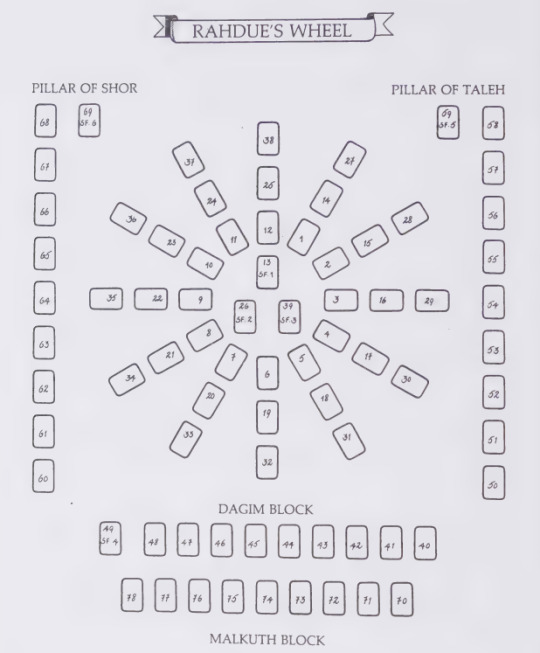
Tackling the ‘Size’ Premise
Let’s get the premise out of the way: Rahdue’s Wheel does not use all 78 cards. When you look at the spread in detail, it’s broken down into 7 sections:
Inner Wheel - Present
Center Wheel - Future
Outer Wheel - Past
Dagim Block - Past life
Taleh Pillar (right side) - Past life relationships
Shor Pillar (left side) - Past life memories/experiences
Malkuth Block - Answers the 9 questions you are supposed to have asked before the reading
The last section, the Malkuth Block, is optional. Even if you choose to use it, you may not pull the rest of your deck. Connolly says “Any cards that have not been used are left face down and are not to be read. They do not pertain to the reading and leaving them face down retains the original energy of the spread. If you turn them over, you break the esoteric structure of the entire spread.” At most, this spread requires 69 cards, not 78.
The Popular Criticisms
While its gimmick is an exaggeration, it is still a behemoth of a spread. Many believe it is unwieldy and bogged down with too much information. This is a common criticism of larger spreads; the more information you pull, the easier it is to get lost. The continual energy drain of pulling, followed by the mental drain of interpreting, can leave you with inaccurate results.
However, this is assuming that you have to do your tarot readings in one sitting. I don’t hold with that idea. You can take on the Wheel in parts, doing a section a day for a week. Or, you can pull all the cards one day, write down what you got, and then do the interpreting the next day. Personally, I think if you have the time, dedication, and skill to parse through all the information, you should be able to get good information out of a large reading.
The Information
In my opinion, Rahdue’s Wheel’s failure is not due to its size, but the quality of information it gives you.
While I approached this spread with the assumption that most people will read it for themselves, Connolly goes back and forth on the role of her readers. In most of the section dedicated to Rahdue’s Wheel, she talks exclusively about “the client”, implying she is writing for a professional tarot reader and the reading is meant to be between two people (reader & querent). However, at one point, she advises the reader to do the Rahdue’s Wheel for themself four times a year, and there are a couple of “for yourself or the client”’s sprinkled throughout the section.
I bring this up because this spread is not very good if you’re reading for yourself. The three wheels are the exact same questions; the only thing that changes is the tense. I know what my current health concerns are, and likely I know what my past ones were. The entire past wheel is redundant, as you’re just reliving everything without added context or commentary. Pulling a Three of Swords for past relationships tells me a break-up really hurt me, but it doesn’t tell me how that’s still affecting me. There’s no new information given to the querent beyond “this is how your life and philosophies have changed”.
The redundancy cuts both ways in the reader/querent question. If you read for yourself, you’re wasting time and energy on things you already know. On the other hand, if you’re reading for someone else, you’re not giving the querent new information that can solve their problems. If anything, it’s spiritual junk food; the reader gets to come off as intuitive and knowledgeable (assuming the cards are all accurate), while not giving any real advice. The querent will leave feeling fulfilled from their amazing connection with the reader without any new ideas on how to fix their situation.
The Past Life Issue
The other issue that becomes apparent right away is the focus on past lives. The wheels total 39 cards, while the past life sections total 30. This makes the past lives sections nearly half of the spread. Connolly believes that our actions and mindsets are influenced by the hidden memories and traumas of our past lives. She rationalizes that knowing about these lives is a good way to look deeper into the querent’s psychology. This gives us context for the previous problem: The reason we’re looking at every aspect of a person’s life is to find patterns stemming from the past lives. If we find your past life was betrayed by a lover, we know the root cause of your commitment issues. The wheels and the past lives sections work together to illuminate the overarching themes of the querent’s karmic life.
This creates multiple barriers in order to make this spread work:
You must believe in past lives as a concept
You must believe you personally have at least one past life
You must believe that issues from your past life can affect your current life
If you have all three beliefs, then this spread can do amazing things for you! But many people don’t have all three. I can’t get past the third one myself; I think it’s possible to connect with and learn from your past lives, but I don’t think their traumas become ours. For many, they don’t have the necessary beliefs to bridge the gap between the two halves of the spread.
Even if you do believe past lives can affect our current lives, this spread still runs into the problem we discussed earlier: there is no advice given. At best, the reader will probably say to do “past life work” before sending you on your way. Knowing where your issues stem from can be helpful, but the knowledge itself won’t change anything. Ultimately, to see change you need a direction to go in. This spread will not give that to you.
Finally Answering the Questions
Let’s revisit the Malkuth Block, the tarot reading within the tarot reading. Once the diviner has exhausted themselves sorting through every facet of your lives (present and past), it’s time to actually answer those questions you had that brought you to a reader in the first place. Connolly leaves it up to the reader to determine how many cards should be pulled per question. As I mentioned earlier, she says not every card will be flipped over and read, but then she goes on to say that if the querent only has one question, you must read all 9 cards in the Block. She does not give an explanation for this; I assume something to do with the “esoteric structure” but who knows.
At this point, you’re doing a basic tarot reading. Surprisingly, many tarot readers are able to do “here’s the answer to your question” readings without knowing every single thing about you. If you’re just trying to get questions answered, the majority of this spread is unnecessary. It’s also incredibly damaging; by putting the questions at the end of the marathon spread, you get to the important part of the reading when the diviner is exhausted.
Conclusion
Rahdue’s Wheel works well for very specific situations, like when you want to do past life work and don’t know what to focus on. But for the average reader this spread is too bloated. Not only is the size too large for most people to read accurately in one sitting, but the information it gives you is useless. You’re better off finding a smaller spread.
While some use Rahdue’s Wheel as practice, I think most people bookmark it purely as a challenge spread to do “some day”. But this spread does work if you use it within the beliefs and framework Connolly created it for. I would bet there are a lot of people out there looking for just this kind of spread to help them with their past lives. They’ve probably heard the name before, but pass over it because no one talks about it as a past life spread or a karmic spread. They only talk about it as “The Ultimate Spread”. It’s become clickbait, in tarot form.
82 notes
·
View notes
Text

offering to lady Aphrodite ❤️
130 notes
·
View notes
Photo
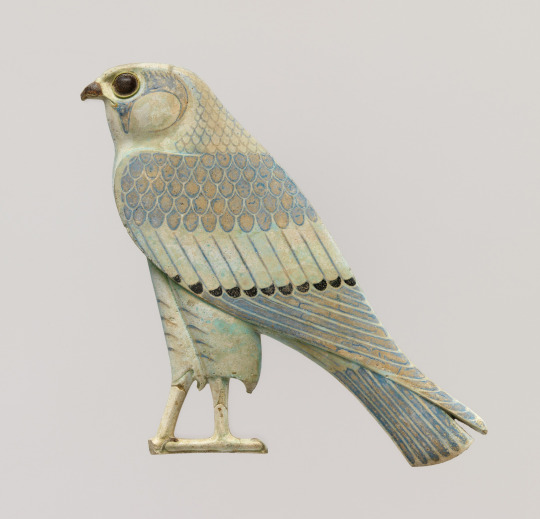
Horus falcon inlay, made in Egypt in the 4th century (source).
7K notes
·
View notes
Text
To Chloris, Goddess of Flowers
Dear Goddess of scents so sweet,
I see you now, blooming, smiling,
Within my garden, you help the sprouts
Begin to flourish.
The tulips are braving the cold of night
To show off their vibrant petals.
The lilac, it buds so eagerly
At your soft touch
Wanting so dearly to be caressed by your loveliness.
Chloris, beloved and beautiful,
Your presence is in the air,
Spring is enlivened by your joyful dance.
Dear Goddess of the Delicate Flower,
I see you now, blooming, smiling,
Within my garden,
And I can’t help but smile too.
67 notes
·
View notes
Text
The knowledge of some common plants
Since many people don't know most of the plants around them, this is information on some plants that are commonly seen in many places throughout the world

This is Lamium purpureum, also called Purple Deadnettle.
It's called deadnettle because it looks like a nettle but it doesn't sting you
This plant is a winter annual—it grows its leaves in the fall, lasts through the winter, and blooms and dies in the spring
Its pollen is reddish orange. If you see bees with their heads stained reddish orange, it is likely because they have visited Purple Deadnettle
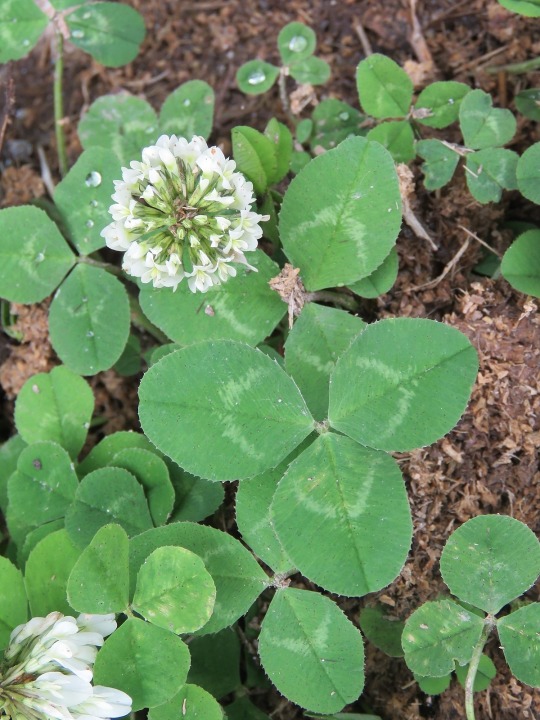
This is Trifolium repens, white clover
It is a legume (belongs to the bean family) and fixes nitrogen using symbiosis with bacteria that live in little nodules on its roots, fertilizing the soil
It is a good companion plant for the other members of a lawn or garden since it is tough, adaptable, and improves soil quality. According to my professor it used to be in lawn mixes, until chemical companies wanted to sell a new herbicide that would kill broadleaved plants and spare grass, and it was slandered as a weed :(
It is native only to Europe and Central Asia, but in the lawns they are doing more good than harm most places
Honeybees love to visit clover
Four-leaf clovers are said to be lucky
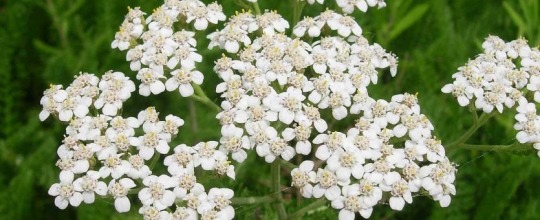
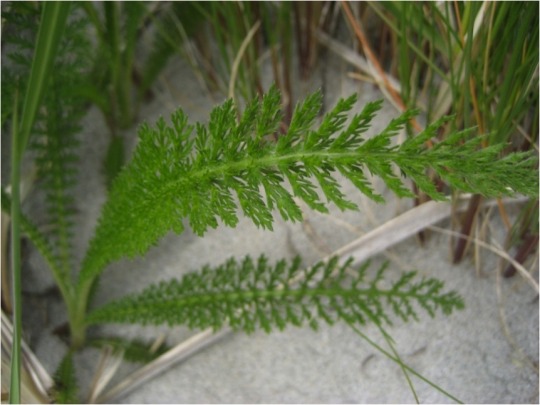
This is Achillea millefolium, Common Yarrow
It has had a relationship with humans since Neanderthals were around, at least 60,000 years, since Neanderthals have been found buried with Yarrow
Its leaves have been used to stop bleeding throughout history, and its scientific name comes from how Achilles was said to have used Yarrow to stop the blood from the wounds of his soldiers. A leaf rolled into a ball has been used to stop nosebleeds
It is a native species all throughout Eurasia and North America

This is Cichorium intybus, known as Chicory
The leaves look a lot like dandelion leaves, until in mid-spring when it begins growing a woody green stem straight up into the air
Like many other weeds, it has a symbiotic relationship with humans, existing in a mix of domesticated or partially domesticated and wild populations
It is native to Eurasia, but widespread in North America on roadsides and disturbed places, where it descended from cultivated plants
Its root contains large amounts of inulin, which is used as a sweetener and fiber supplement (if you look at the ingredients on the granola bars that have extra fiber, they usually are partly made of chicory root) and has also been used as a coffee substitute
A large variety of bees like to feed upon it

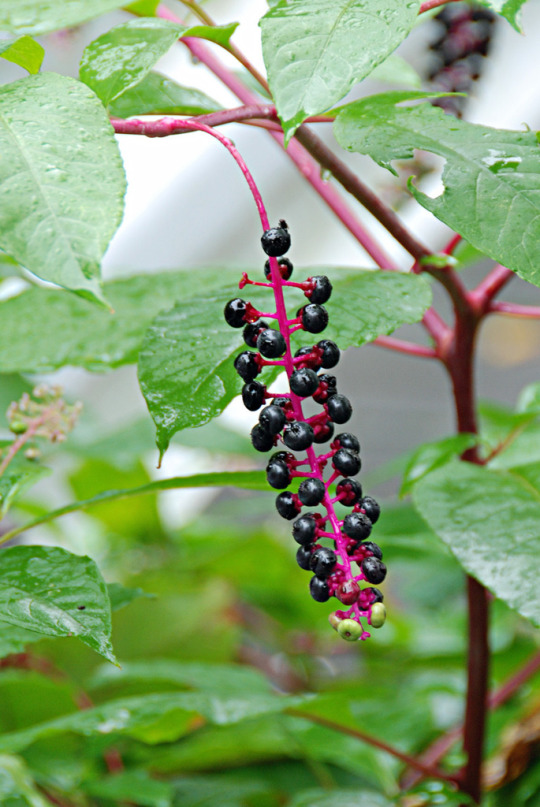
This is Phytolacca americana, known as Pokeweed
It is easily identified by its huge leaves and its waxy, bright magenta stem
It can grow more than nine feet tall from a sprout in a single summer!
If you squish the berries, the juice inside is a shocking magenta that is so bright it almost burns your eyes. For this reason many Native American people used it for pink and purple dye.
It is a heavy metal hyperaccumulator, particularly good for removing cadmium from the soil
All parts of the plant are poisonous and will make you very sick if you eat them, however if the leaves are picked when very young and boiled 3 times, changing out the water each time, they can be eaten, and this is a traditional food in the rural American Southeast, but I don't want to chance it
British people have introduced it as a pretty, exotic ornamental plant. I think that is very funny considering that here it is a weed associated with places where poor people live, but maybe they're right and I need to look closer to see the beauty.
If you see magenta stains in bird poop it is because they ate pokeweed berries- birds can safely eat the berries whereas humans cannot

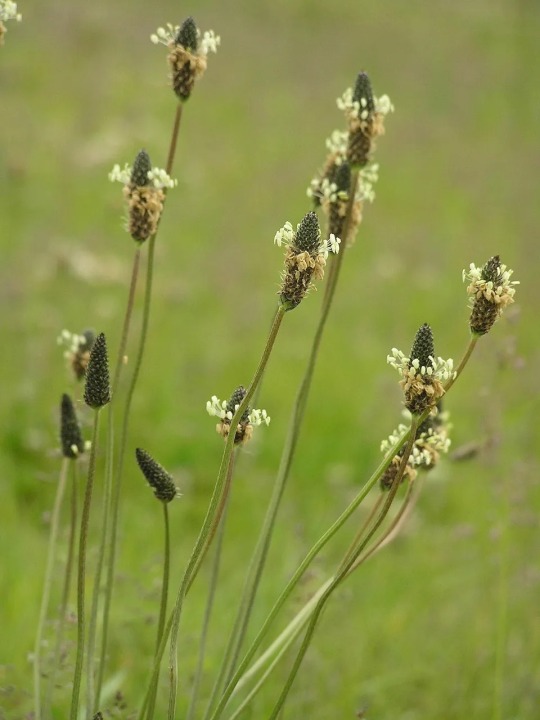
This is Plantago lanceolata, Ribwort Plantain
It grows in heavily disturbed soils, in fact it is considered an indicator of agricultural activity. It is successful in the poorest, heaviest and most compacted soil.
The leaves, seeds, and flower heads are said to be edible but the leaves are really stringy unless they are very young. Of course, it is important to be careful when eating wild plants, and make sure you have identified the plant correctly and the soil is not contaminated
I have also heard the strings in the leaves can be extracted and used for textile purposes
and that's some common plants you might often see throughout the world
4K notes
·
View notes
Text
Hekate
"Keeper of Ravenous Dogs,
Bitch Goddess,
Howler,
Bearer of Torch and Knife,
Ruler of the Dark Moon:
Hekate, I pray to you.
Turn you slaying glance from me
and direct it toward my enemies.
And if you can't turn it away,
may it be because there is something in me that must die.
Act with wisdom and discernment, destroying only what must go,
and giving me strength to endure the burning."
A Book of Pagan Prayer by Ceisiwr Serith, pg. 240
#hellenic#hellenic polytheism#hellenic prayers#hekate#hecate#helpol#pagan#paganism#paganblr#pagan prayers#prayers#quotes
33 notes
·
View notes
Text
Demeter
"I pray to you, Demeter, to remind you of the spring,
for Persephone has come home to you,
your little girl, now a great queen.
Show us your joy, mother of grain,
at her homecoming.
Warm the Earth, make the ground soft,
so we may walk barefoot again in the grass
and plant seeds that will grow all summer
until the harvest, when your full power will be known
and everyone will see what you have done.
But now it is the time to begin these great deeds.
Bring us the spring, that together we might produce the harvest.
Warm the Earth, that plants might grow to we might display your gifts.
With your tears cried for happiness, melt away the winter's snow
and nourish the waiting seeds."
A Book of Pagan Prayer by Ceisiwr Serith, pg. 178
#hellenic#hellenic polytheism#demeter#spring equinox#prayers#hellenic prayers#pagan#paganism#paganblr#pagan prayers#helpol#quotes
19 notes
·
View notes
Text
"Surrounded by the forest's trees, I am surrounded by the spirits of the forest. I sit here, on the needles and leaves, and spread my arms in greeting. Come to me, if you wish; I hope for your coming. I wait here for you, hoping to see you. And if you do not come, I will still leave these gifts for you, for my hands are not closed. My hands are open in generosity toward you, they are extended in friendship towards you."
A Book of Pagan Prayer by Ceisiwr Serith, pgs. 103-104
8 notes
·
View notes
Text
"The Serpent King is stirring within me,
awakening, his fire and force growing.
The raving one awakes, who is spendthrift with his power,
breaking through, breaking down, breaking apart what is outworn.
Do what you must, thunder and lightning,
but leave behind a newly ordered creation,
an oak growing from the wet ground."
A Book of Pagan Prayer by Ceisiwr Serith, pg. 94
12 notes
·
View notes
Photo

Nymph with Child and Infant Faun by Jules Visseaux (1900-20)
1K notes
·
View notes
Text

Rough moonstone!
It has a beautiful, pearly iridescence called adularescence, which shimmers with a blue or white light when the stone is moved.
Photo: elfkendalhippies
295 notes
·
View notes
